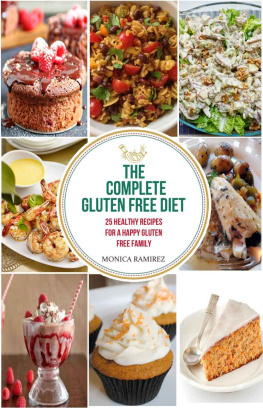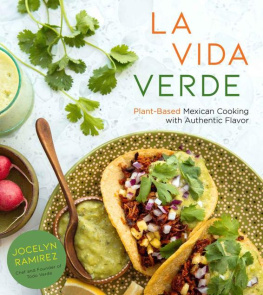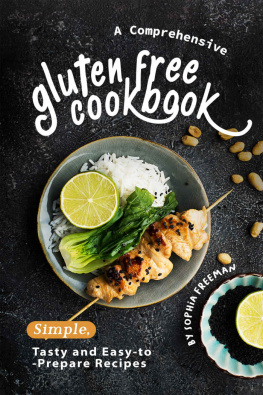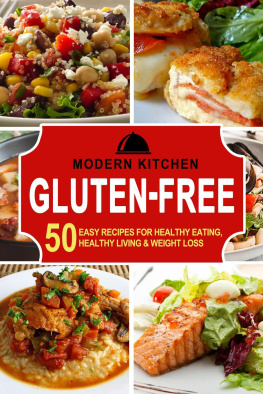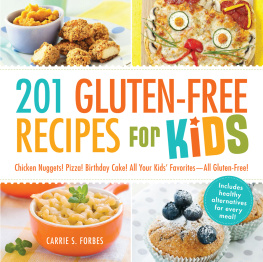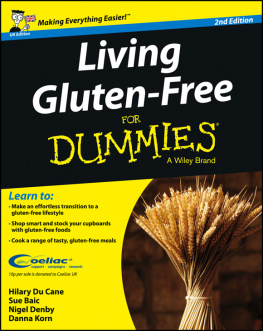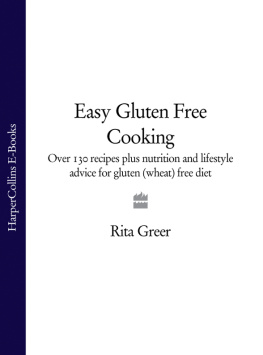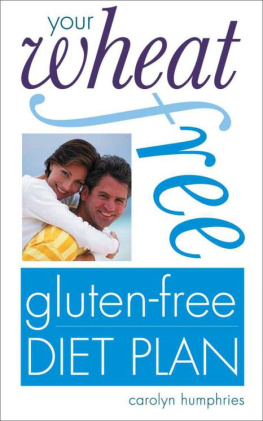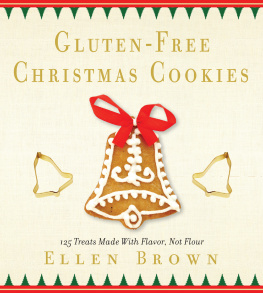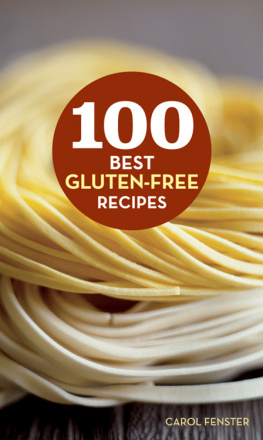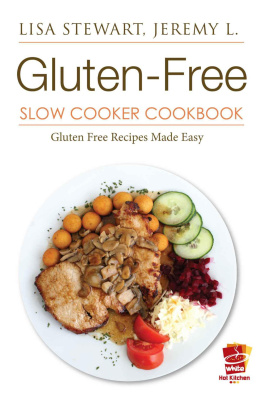The Complete Gluten Free Diet
25 Recipes for a happy gluten free family
Monica Ramirez
Copyright 2015 Monica Ramirez. All rights reserved. No part of this book may be reproduced or transmitted in any form or by any means, electronic, mechanical, photocopying, recording, or otherwise without the prior written permission of the publisher.
Disclaimer
The information provided in this book is designed to provide helpful information on the subjects discussed. This book is not mean to be used, nor should it be used, to diagnose or treat any medical condition. For diagnosis or treatment of any medical problem, consult your physician. The publisher and author are not responsible for any specific health or allergy needs that may require medical supervision and are not liable for any damages or negative consequences from any treatment, action, application or preparation, to any person reading or following the information in this book. Any references included are provided for informational purposes only and do not constitute endorsement of any websites or other sources.
Please accept my gift to you, a complimentary ebook dedicated to croissant lovers:) Click here to get your free ebook J'adore le croissant
Check out my other book on Amazon 15 Minutes Daily Workout That Will Kick Your Butt Into Shape
Hello reader:
If this is the first time you have picked up one of my books, thank you so much! Get ready to change your life with this gluten free diet! If you really want to achieve excellent healthand achieve the best you can be, you need to get gluten out of your life. This book will explain to you why.
To those who have been reading my other books, again thank you too but hold on because I've got a couple of more tools to add to your journey to good health.
We will additionally include practical eating guides, tips to cleanse your body and ways to avoid toxins that make you sick. We designed this book in a practical and no-fuss way as possible for your benefit.
Thank you again and we wish you good health!
Monica Ramirez
Table of Contents
What is Gluten?
Gluten is an elastic substance found in grains such as wheat, barley and rye. The Wikipedia entry for gluten states, Gluten (from Latin gluten- "glue") is protein composite found in wheat and related grains, including barley and rye. Gluten gives elasticity to dough, helping it rise and keep its shape and often gives the final product a chewy texture.
This means that gluten is nearly everywhere, most especially on processed food items. The supermarkets are full of foods that contain gluten and you will be surprised to see that gluten is found in almost every product from cereal to salad dressings.
You can see below on how gluten can end up on foodstuffs we purchase:
- Wheat is found in baked products, soups, breads and pasta
- Barley is found in food colouring, malt vinegar, beer
- Rye is found in rye bread, rye beer and cereals
Gluten is a concern because it is associated with several medical conditions. Gluten itself has absolutely no nutritional or health-promoting value our bodies have no use for it. Sugar, which also faced similar loathing, has some nutritional value as a source of energy. There is no medical information or study concluding that consumption of glutencan promote good health.
Instead, gluten causes disease. Humans have varying degrees of intolerance to gluten, some may feel no symptoms at all while others experience full-blown symptoms of gluten intolerance. If you do have gluten intolerance, which means that your body is getting wrecked from gluten you eat from food.
Okay, I will go straight to the point here. Gluten in our food makes us sick and we must do something to get it out in our life.You will find this book very useful in adopting a gluten-free lifestyle. The steps of removing gluten must be done correctly, and I will teach you how to do it right.
Can you still eat grains? Yes you can!
Gluten-free does not mean that you will say no to grains for life. There are also varieties of gluten-free grains that you can cook delicious meals with and prove filling. We have corn, millet, oats, brown rice, sorghum, teff, wild rice, buckwheat, and amaranth.
Millet is being used widely in India and Africa. Millet can be cooked as pilaf like rice. When cooked with higher percentage of water, millet develops a creamier texture like mashed potatoes and makes it well suited for breakfast porridge. Millet is high in B vitamins and fiber and has pleasant mild taste.
Buckwheat is not actually related to wheat, and to our surprise is not a cereal grain. Buckwheat is widely used in Eastern Europe and Asia and can be enjoyed as side dish or in stuffing.Buckwheat flour is used in Japanese cuisine to make soba noodles and in America to make pancakes. Buckwheatis an excellent source of fiber, riboflavin and niacin.
Amaranth seed has a nutty flavour and unique texture, being gelatinous and somewhat crunchy at the same time. Due to its thickening properties,amaranth is excellent as an addition to soups and casseroles or as breakfast porridge. The flour works great for making gravy. Amaranth is high in fibre and minerals.
Oats is an excellent source of fiber as well as zinc and B vitamins. Some celiac sufferers experience difficulty in eating oats and it is advisable to consult your doctor before adding it to your gluten free diet.
Quinoa is a great source of iron, calcium, magnesium, fiber and B vitamins. Due to its bitter saponin coating, quinoa must be rinsed several times prior to cooking. Quinoa cooks relatively quickly,tastes great and can replace rice in most recipes.
Rice is the most popular of the gluten-free grains. Some rice varieties have subtle aroma, like basmati and jasmine that have nutty and floral flavours.
Sorghum is a grain used in porridge or as an addition to pilaf, casseroles and soups. Sorghum flour has a slightly sweet and nutty flavour and works well with bean flours like garbanzo or fava bean flour.
Teff is a tiny seed that grows in Africa. It is used to make a flat, spongy bread called injera, which is a staple in Ethiopian cuisine. Teff has a high mineral content, including calcium, iron, magnesium and zinc.
Wild rice, native to North America, is not a member of the rice family. This grass, previously a staple for several Native American tribes, continues to grow wild in the Great Lake region. Most of the wild rice available in stores today is commercially grown. Wild rice is high in zinc, magnesium and folate as well as fiber.
The problem with gluten
The problem with gluten is that it is associated with many medical conditions. Our bodies actually view gluten as a foreign non-food substance. Gluten provokes the immune system to respond pathologically and result to disease. This same thing happens in the condition celiac disease. Thus, we can say that anyone has celiac diseaseor gluten intolerance, which by the way are synonymous.
There are literally tens of symptoms of gluten intolerance, few of which are gastrointestinal related. Several more are associated with serious medical conditions.
The most common symptoms of gluten intolerance are:
- Unexplained fatigue
- Gastrointestinal distress (gas, bloating, diarrhea, constipation, vomiting, reflux)
- Headaches (including migraines)
- Mouth sores
- Unintended weight loss/gain
- Inability to concentrate
- Moodiness/depression
- Amenorrhea/delayed menarche (menstrual cycles)
- Bone/joint/muscle pain
- Tingling numbness in the legs
- Thinning of scalp hair
- Anemia
- Chronic abdominal pain
Celiac disease or gluten intolerance worsens symptoms of the following conditions:
- Crohns disease
- Dermatitis herpetiformis (a sister of celiac disease)
Next page
